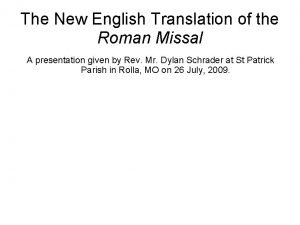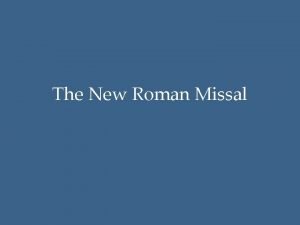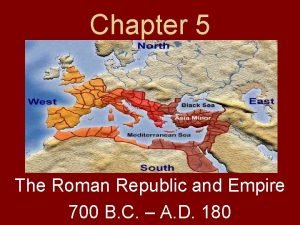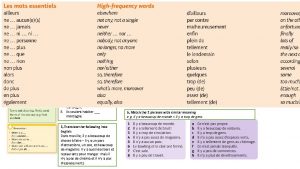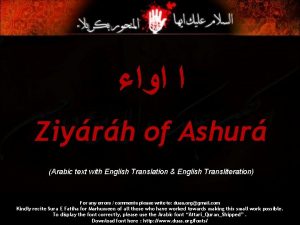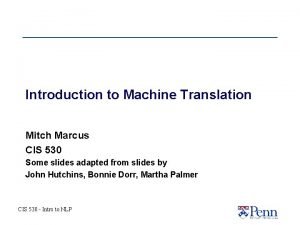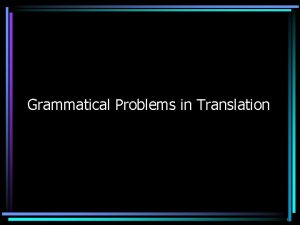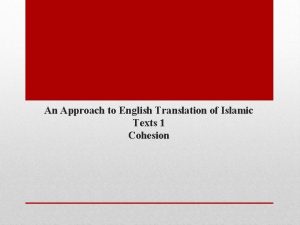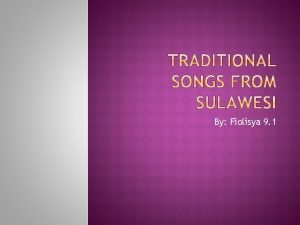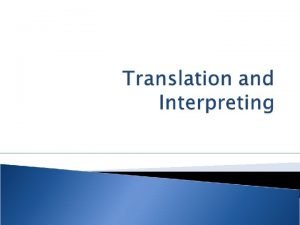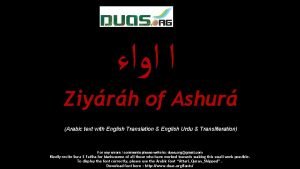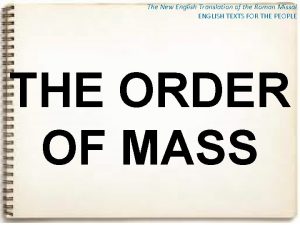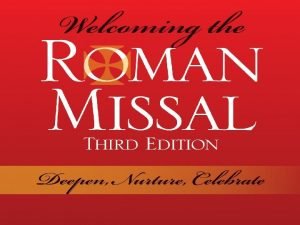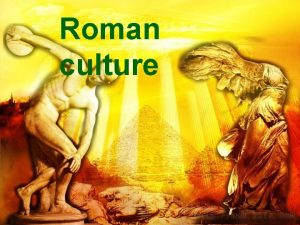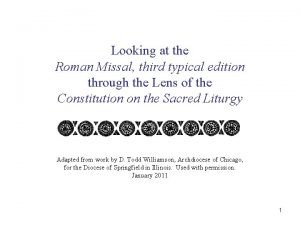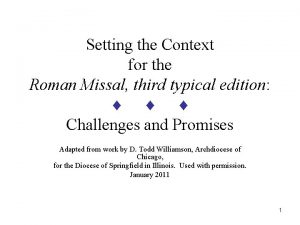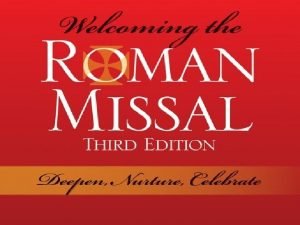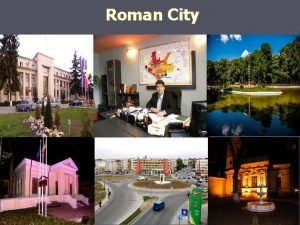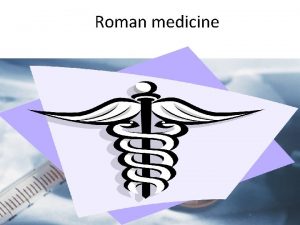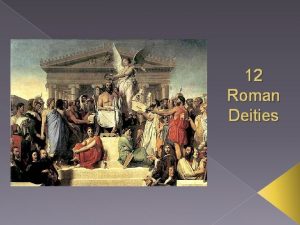The New English Translation of the Roman Missal


































- Slides: 34

The New English Translation of the Roman Missal A presentation given by Rev. Mr. Dylan Schrader at St Patrick Parish in Rolla, MO on 26 July, 2009.

A Note on Terminology “The Latin Rite” or “The Latin Church” refers to the (by far) largest particular Church of the Catholic Church as opposed to one of the 22 Eastern particular Churches of the Catholic Church. Within the Latin Rite, there are various families of liturgical traditions. Of these, the (by far) most common is the Roman Rite. The Roman Rite can be further subdivided into various “uses” or “forms. ”

A Note on Terminology So: St Patrick Parish is a parish of the Latin Rite and more specifically of the Roman Rite. Every Mass celebrated at St Patrick is Latin Rite/Roman Rite.

A Note on Terminology Therefore, we are speaking in this presentation about the new English translation of the Roman Missal, that is, the primary liturgical book used in the celebration of Mass in the Ordinary Form of the Roman Rite. We will address the Extraordinary Form (1962 Missal) and other pre-Vatican II liturgical books only as a matter of history.

Early Roman Rite Timeline Ca. 33 – The Last Supper. Ca. 56 - St Paul hands on the essential ceremonies of the Mass. (1 Cor. 11: 18 -34) 1 st - 3 rd Centuries – In Rome, the Mass is celebrated in Greek. 4 th Century – By this time, the Church in Rome celebrates Mass in Latin, which was the vernacular of that time. Nevertheless, the liturgical texts in use show a “higher, ” non-colloquial style of Latin than what was spoken in ordinary conversation.

Continuity The Roman Rite developed very early and has been preserved for the majority of the Catholic Church. “In religious matters, people tend to hold on to what they received from the beginning, how their earliest predecessors articulated their religion and prayed. Words and formulae used by earlier generations are dear to those who today inherit from them. ” - Francis Cardinal Arinze (2006), Speech at Gateway Liturgical Conference in St Louis.

Liturgical Language Although early liturgies in the Church were often celebrated in Greek, even in the city of Rome, the language of the Roman Rite once it developed has remained Latin. “The Church, which is called Latin, even though she has also introduced vernacular languages into the Liturgy on account of pastoral advantages, does not stray from her origin, from which her own language is Latin. ” - Pope John Paul II, “De modo ius canonicum docendi, ” Ius et Iustitia (10) p. 12, Rev. Mr. Dylan Schrader, trans.

Liturgical Language “The Roman Church has special obligations towards Latin, the splendid language of ancient Rome, and she must manifest them whenever the occasion presents itself. ” - Pope John Paul II (1980) Dominicae cenae, n. 10.

Current Norms “The Eucharistic celebration is to be carried out either in the Latin language or in another language, provided the liturgical texts have been lawfully approved. ” (Code of Canon Law (1983), can. 928)

The Church's Norms “I ask that future priests, from their time in the seminary, receive the preparation needed to understand to celebrate Mass in Latin, and also to use Latin texts and execute Gregorian chant; nor should we forget that the faithful can be taught to recite the more common prayers in Latin, and also to sing parts of the liturgy to Gregorian chant. ” - Pope Benedict (2007) Sacramentum caritatis, n. 62.

Vernacular Languages in the Roman Rite The Council of Trent considered the question of introducing vernacular languages into the Roman Rite. “Although the mass contains great instruction for the faithful people, nevertheless, it has not seemed expedient to the Fathers, that it should be every where celebrated in the vulgar tongue. Wherefore, the ancient usage of each church, and the rite approved of by the holy Roman Church, the mother and mistress of all churches, being in each place retained; and, that the sheep of Christ may not suffer hunger, nor the little ones ask for bread, and there be none to break it unto them, the holy Synod charges pastors, and all who have the cure of souls, that they frequently, during the celebration of mass, expound either by themselves, or others, some portion of those things which are read at mass, and that, amongst the rest, they explain some mystery of this most holy sacrifice, especially on the Lord's days and festivals. ” (Council of Trent, Session 22, chap. 8)

Vatican II The Second Vatican Council considered the same question. “Particular law remaining in force, the use of the Latin language is to be preserved in the Latin rites. ” (Sacrosanctum concilium, n. 36, § 1)

Vatican II “But since the use of the mother tongue, whether in the Mass, the administration of the sacraments, or other parts of the liturgy, frequently may be of great advantage to the people, the limits of its employment may be extended. This will apply in the first place to the readings and directives, and to some of the prayers and chants, according to the regulations on this matter to be laid down separately in subsequent chapters. ” (Sacrosanctum concilium, n. 36, § 2)

Why Discuss Latin? We mention a bit about Latin because it must be kept in mind that the Mass in English is a translation of the Mass in Latin, which is the universal norm for the Roman Rite. This means that the Mass in English is not a free composition; it needs to be an accurate rendering of the Mass in Latin. As we will see, the new translation preserves much more completely some of the Latin style and other elements that make our liturgy essentially Roman.

Timeline after Vatican II 1965 -1967 – “Transitional” partially vernacular adaptations of the Roman Missal appear in various countries. 1969 / 1970 – Pope Paul VI promulgates the first edition of the revised Roman Missal. Only the readings, some prayers, and the antiphons are translated in most versions. Due to overwhelming demand, the whole Mass is allowed to be translated. 1973 – The ICEL English translation of the 1970 Missal is printed. 1975 – Pope Paul VI promulgates the second edition of the revised Roman Missal.

Liturgiam authenticam In 2001, the Congregation for Divine Worship and the Discipline of the Sacraments issued the instruction Liturgiam authenticam, which provides norms for translations of the sacred liturgy into vernacular languages. The body responsible for translating the liturgical books into English is ICEL: The International Commission on English in the Liturgy.

What is ICEL? The International Commission on English in the Liturgy has eleven full member countries in which English is used. Each country has one bishop that serves on ICEL. The USA's member of the Bishops' Commission of ICEL is the Most Rev. Arthur Serratelli. There are other scholars, etc. that assist in the work of translation.

What about the new translation? Following the instruction Liturgiam authenticam from the Vatican's Congregation for Divine Worship, the new translation of the Missal into English: Is more literal than the current translation. Does not omit adjectives such as holy, sacred, divine where the current translation tends to do so. Does not tend to introduce new elements to the text. Uses a “higher, ” non-colloquial style of English. Preserves the Church's technical vocabulary rather than substitute generic terms, e. g. , not replacing grace with “help. ”

What about the new translation? continued Following the instruction Liturgiam authenticam from the Vatican's Congregation for Divine Worship, the new translation of the Missal into English: Retains phrases such as “grant, ” “you were pleased to, ” “so that, ” etc. which express God's sovereignty and his divine causality. Does not replace terms reflecting objective reality with terms that connote merely psychological or subjective experience, e. g. , substituting “”

Types of Changes

Liturgiam authenticam “Certain words that may appear to have been introduced into the Latin liturgical text for reasons of meter or other technical or literary reasons convey, in reality, a properly theological content, so that they are to be preserved, insofar as possible, in the translation. It is necessary to translate with the utmost precision those words that express aspects of the mysteries of faith and the proper disposition of the Christian soul. ” (Liturgiam authenticam, n. 55)

Technical Vocabulary The current translation tends to: Replace concrete, precise, and technical terms with vague, generic, or abstract words. Omit technical theological terms. Be ambiguous about the logical priority of different concepts: e. g. , not using syntax that shows clearly that God's grace comes before our actions. The new translation: Retains technical terms. Translates them accurately into English. Does a decent job of keeping the main sense of the

Examples: Technical Vocabulary Original ICEL (1973) ICEL (new) Sanctus, Sanctus Dóminus Deus Sábaoth. Holy, holy Lord, God of power and might. Holy, Holy Lord God of hosts. Pleni sunt cæli et terra glória tua. Heaven and earth are full of your glory. Hosanna in excélsis. Hosanna in the highest. Benedíctus qui venit in nómine Dómini. Blessed is he who comes in the name of the Lord. Hosanna in excélsis. Hosanna in the highest.

Examples: Technical Vocabulary Original (Collect for Trinity Sunday) ICEL (1973) ICEL (2008 draft) Deus Pater, qui, Verbum veritatis et Spiritum sanctificationis mittens in mundum, admirabile mysterium tuum hominibus declarasti, da nobis, in confessione verae fidei, aeternae gloriam Trinitatis agnoscere, et Unitatem adorare in potentia maiestatis. Father, you sent your Word to bring us truth and your Spirit to make us holy. Through them we come to know the mystery of your life. Help us to worship you, one God in three Persons, by proclaiming and living our faith in you. God our Father, by sending into the world the Word of truth and the Spirit of sanctification you made known to humankind your awesome mystery; grant us, in professing the true faith, to acknowledge the Trinity of eternal glory, and adore the Unity, powerful in majesty.

Examples: Technical Vocabulary Original (Prayer over the gifts for 17 th Sunday) Súscipe, quaesumus, Dómine, múnera, quae tibi de tua largitáte deférimus, ut haec sacrosáncta mystéria, grátiae tuae operánte virtúte, et praeséntis vitae nos conversatióne sanctíficent, et ad gáudia sempitérna perdúcant. Per Christum Dominum nostrum. ICEL (1973) Lord, receive these offerings chosen from your many gifts. May these mysteries make us holy and lead us to eternal joy. We ask this through Christ our Lord. ICEL (2008 draft) Accept, O Lord, we pray, the gifts we bring you from your bounty that through the powerful working of your grace these most sacred mysteries may both sanctify us in the way we live now and lead us to everlasting joys. Through Christ our Lord.

Liturgiam authenticam “For this reason the manner of translating the liturgical books should foster a correspondence between the biblical text itself and the liturgical texts of ecclesiastical composition which contain biblical words or allusions. ” (Liturgiam authenticam, n. 49)

Examples: Scriptural Allusions Original Domine, non sum dignus ut intres sub tectum meum, sed tantum dic verbo et sanabitur anima mea. ICEL (1973) Lord, I am not worthy to receive you, but only say the word and I shall be healed. ICEL (new) Lord, I am not worthy that you should enter under my roof, but only say the word and my soul shall be healed.

Liturgiam authenticam “Certain expressions that belong to the heritage of the whole or of a great part of the ancient Church, as well as others that have become part of the general human patrimony, are to be respected by a translation that is as literal as possible, as for example the words of the people’s response Et cum spiritu tuo, or the expression mea culpa, mea maxima culpa in the Act of Penance of the Order of Mass. ” (Liturgiam authenticam, n. 56)

Examples: Traditional Expressions Original ICEL (1973) ICEL (new) V. Dominus vobiscum. V. The Lord be with you. R. Et cum spiritu tuo. R. And also with you. R. And with your spirit.

Liturgiam authenticam “It is to be kept in mind from the beginning that the translation of the liturgical texts of the Roman Liturgy is not so much a work of creative innovation as it is of rendering the original texts faithfully and accurately into the vernacular language. While it is permissible to arrange the wording, the syntax and the style in such a way as to prepare a flowing vernacular text suitable to the rhythm of popular prayer, the original text, insofar as possible, must be translated integrally and in the most exact manner, without omissions or additions in terms

Examples: Syntax and Style Original ICEL (1973) ICEL (new) Te ígitur, clementíssime Pater, per Iesum Christum, Fílium tuum, Dóminum nostrum, súpplices rogámus ac pétimus, uti accépta hábeas et benedícas + hæc dona, hæc múnera, hæc sancta sacrifícia illibáta, in primis, quæ tibi offérimus pro Ecclésia tua sancta cathólica: quam pacificáre, custodíre, adunáre et régere dignéris toto orbe terrárum: una cum fámulo tuo Papa nostro N. et Antístite nostro N. et ómnibus orthodóxis atque cathólicæ et apostólicæ fídei cultóribus. We come to you, Father, with praise and thanksgiving, through Jesus Christ your Son. Through him we ask you to accept and bless + these gifts we offer you in sacrifice. We offer them for your holy catholic Church, watch over it, Lord, and guide it; grant it peace and unity throughout the world. We offer them for N. our Pope, for N. our bishop, and for all who hold and teach the catholic faith that comes to us from the apostles. To you, therefore, most merciful Father, we make humble prayer and petition through Jesus Christ, your Son, our Lord: that you accept and bless + these gifts, these offerings, these holy and unblemished sacrifices, which we offer you first of all for your holy catholic Church. Be pleased to grant her peace, to guard, unite and govern her throughout the whole world, together with your servant N. our Pope and N. our Bishop, and all those who, holding to the truth, hand on the catholic and apostolic faith.

Timeline The new Order of the Mass was recently approved by the Vatican. The USCCB very recently approved a new draft of many of the Propers. The projected date for completion of the USCCB's work is 2010. Once the whole work has been approved by the Vatican, a new English translation of the Roman Missal will be promulgated.

Finis. The end.

For More Information: http: //www. usccb. org/liturgy/missalformation Examples of ICEL (1973) translations and English examples from the upcoming Ordo Missae are copyright ICEL, inc.
 Domine non sum dignus translation
Domine non sum dignus translation Penitential act prayer
Penitential act prayer Semantic vs communicative translation
Semantic vs communicative translation Cisco voice translation-rule
Cisco voice translation-rule Transformations of functions
Transformations of functions Noun phrase example
Noun phrase example Roman republic vs roman empire
Roman republic vs roman empire Roman republic vs roman empire
Roman republic vs roman empire Romeo and juliet chorus act 1
Romeo and juliet chorus act 1 Exodus 20 14
Exodus 20 14 1 thessalonians 5 18 nlt
1 thessalonians 5 18 nlt Jis naam mein hai mukti
Jis naam mein hai mukti Surah baqarah word to word translation
Surah baqarah word to word translation Short swahili poems
Short swahili poems Patricia va a california chapter 1 english translation
Patricia va a california chapter 1 english translation Transposition in translation
Transposition in translation Dua e sabah with urdu translation
Dua e sabah with urdu translation اا
اا Die kind kortverhaal
Die kind kortverhaal 1translate
1translate Translation to english
Translation to english What is a verbal adjective
What is a verbal adjective Chinese to english translation
Chinese to english translation Grammatical problems in translation
Grammatical problems in translation Chinese to english translation
Chinese to english translation An approach to english translation of islamic texts
An approach to english translation of islamic texts Translation to english
Translation to english Si patokaan instruments used
Si patokaan instruments used Dot translation in english
Dot translation in english English translation
English translation Magna carta meaning
Magna carta meaning Bria robertson
Bria robertson Present continuous tense urdu to english translation
Present continuous tense urdu to english translation English translation
English translation Ma antjie krog poem analysis
Ma antjie krog poem analysis
